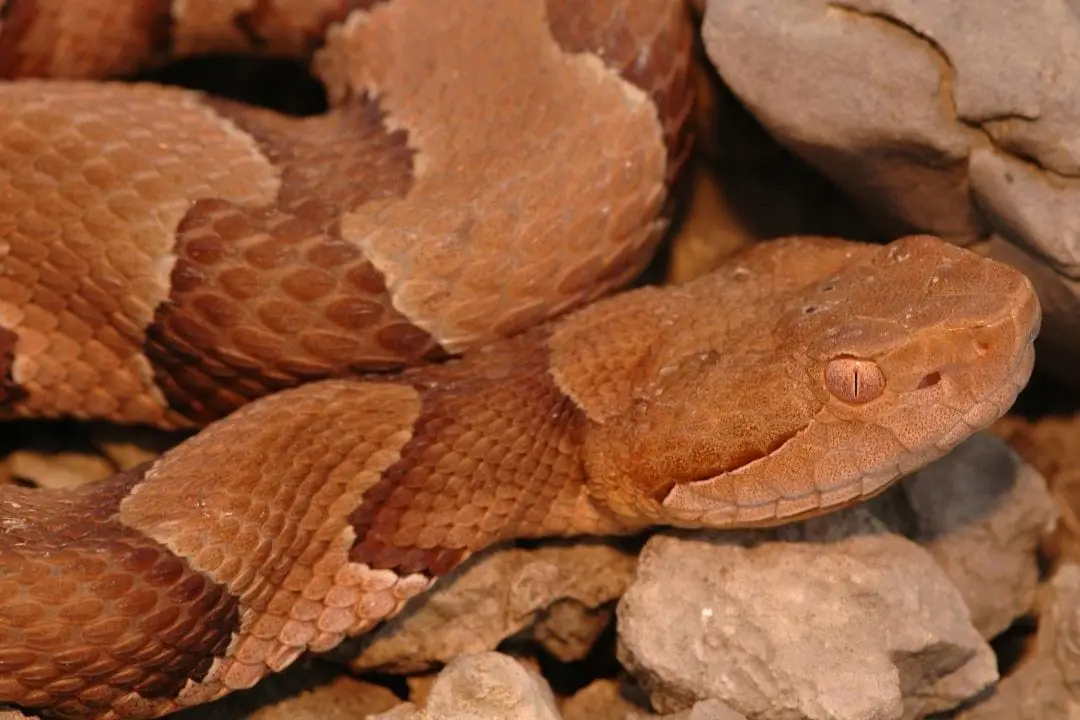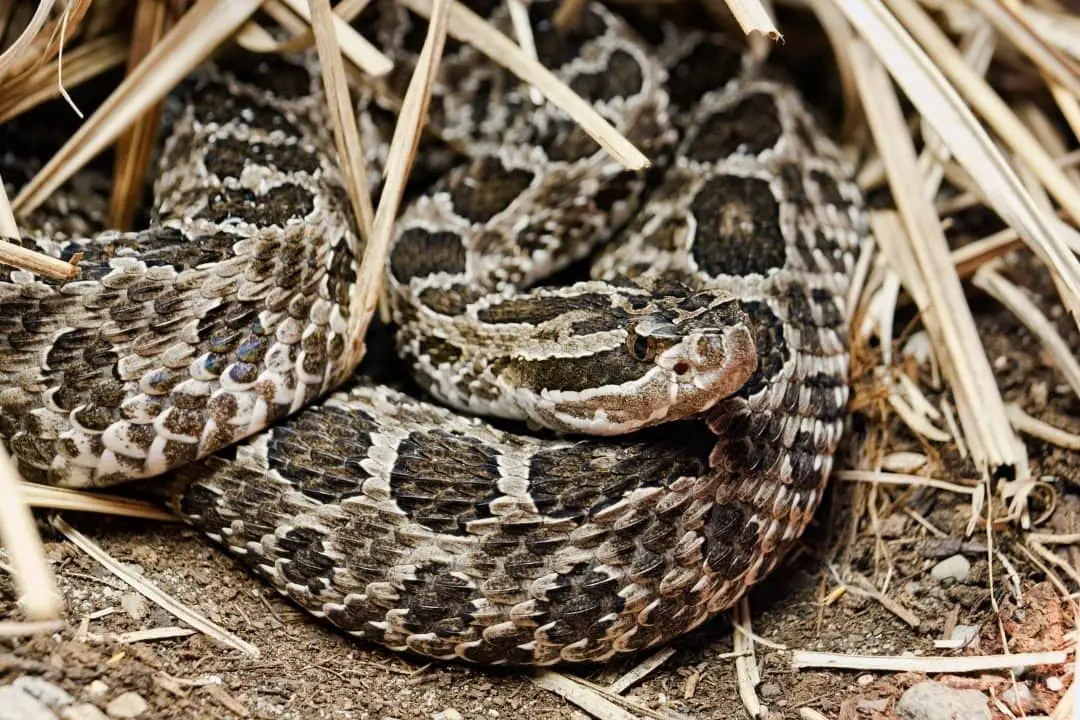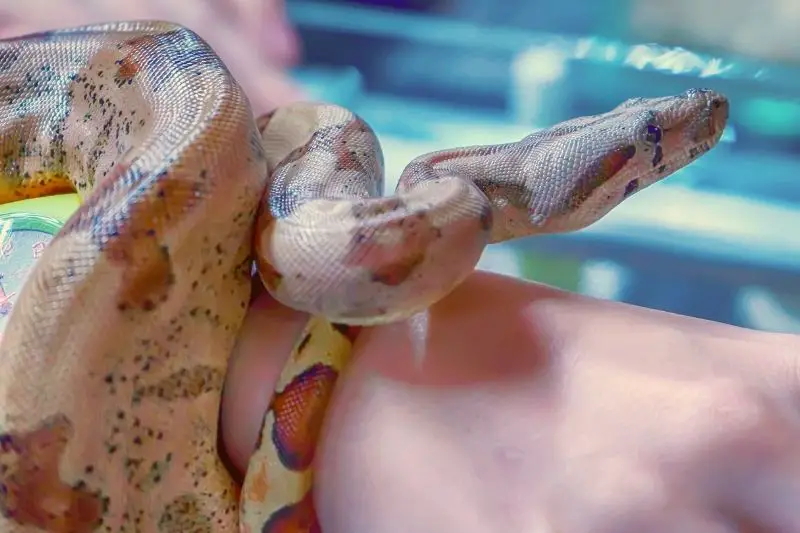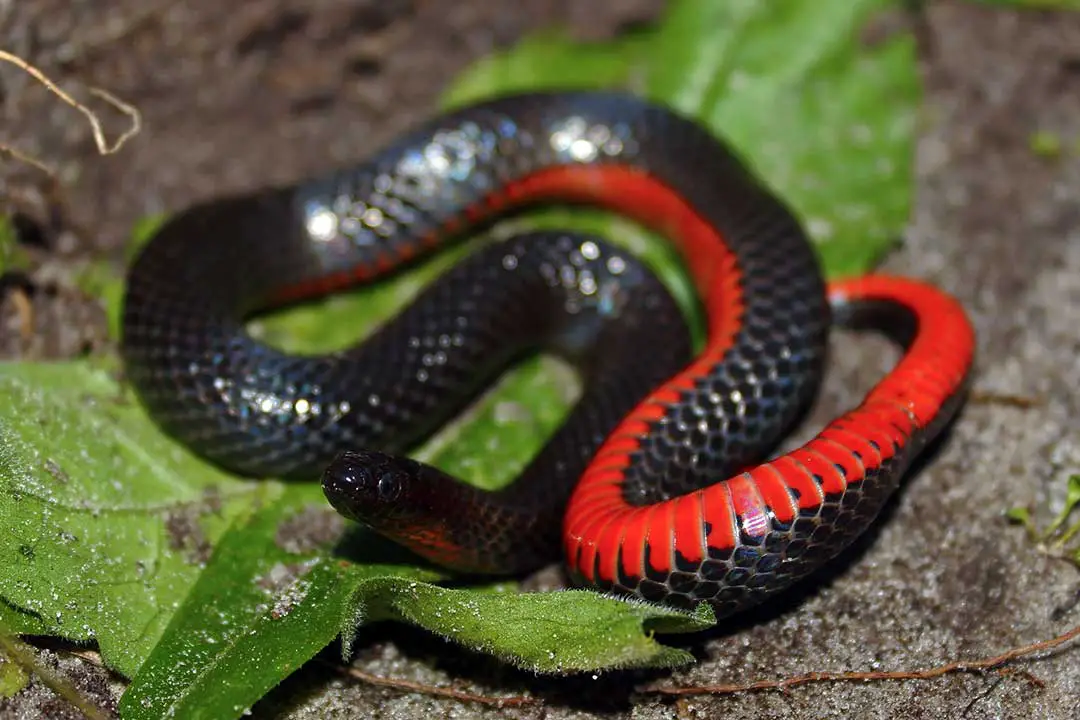There are many species of snakes. Some of these snakes are venomous. Venomous snakes are typically animals that have venom that is medically significant to humans.
This means that a bite from these species can cause minor to serious health concerns that need medical attention. Some species also have venom, but they can’t really cause harm to humans.
We will go over the species of venomous snakes in Texas. There are four groups of venomous snakes which are rattlesnakes, copperheads, cottonmouths, and coral snakes.
Rattlesnakes
Rattlesnakes are some of the easiest venomous snakes to identify.
They all have a rattle on their tail that they shake to warn off potential predators like humans. It can be hard to tell on hatchlings since they only have one segment, but older snakes have many rattle segments to make louder sounds.
There are quite a few species and subspecies of rattlesnakes in Texas. Rattlesnakes in Texas either belong to the Crotalus genus or the Sistrurus genus.
Sistrurus is an older genus than Crotalus. Most rattlesnakes do not have deadly venom, but their bites are painful and can cause very serious damage if they do not receive prompt medical treatment.
Baby rattlesnakes only have a few segments of their rattle, so they may not make much sound and be easily mistaken for other species. However, even a baby rattlesnake can cause serious pain and harm.
1. Western Diamondback Rattlesnake
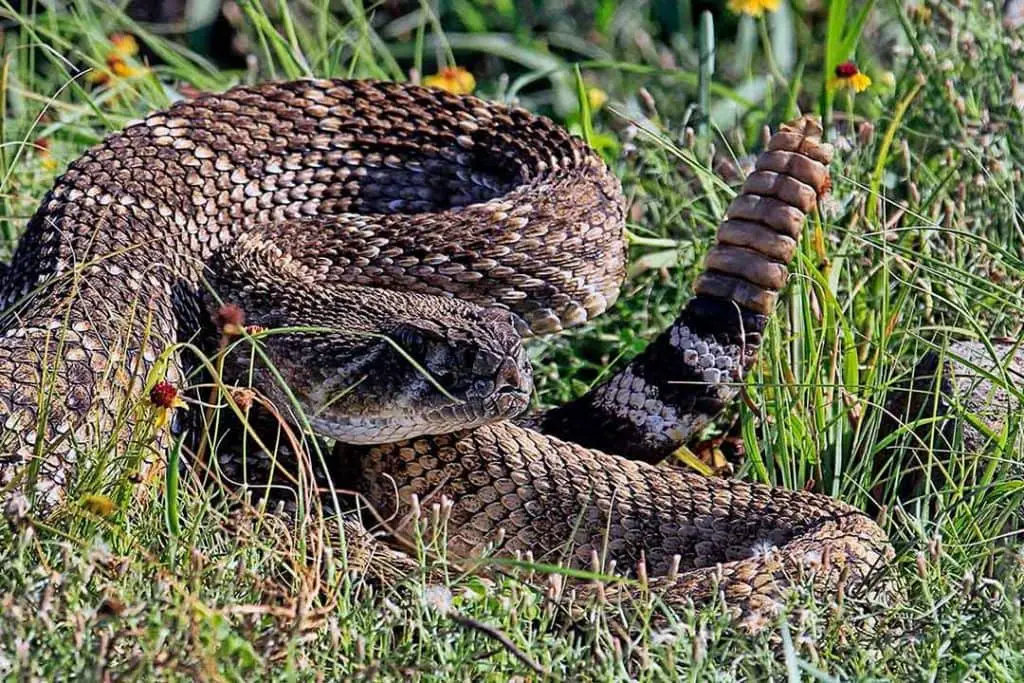
The Western diamondback rattlesnake (Crotalus atrox) is the most common rattlesnake in Texas.
It can be found mainly in Central and Western Texas. They tend to be 3 to 4 feet long as adults and can weigh up to 14 pounds. They are brown with a distinctive diamond pattern going down the back.
They are pit vipers and have a broad head with heat-sensitive pits under the eyes that allow them to track warm-blooded prey.
Their venom is hemotoxic and is fatal in about 10 to 20% of cases without medical treatment. They are shy and will prefer to avoid you if at all possible.
2. Timber Rattlesnake
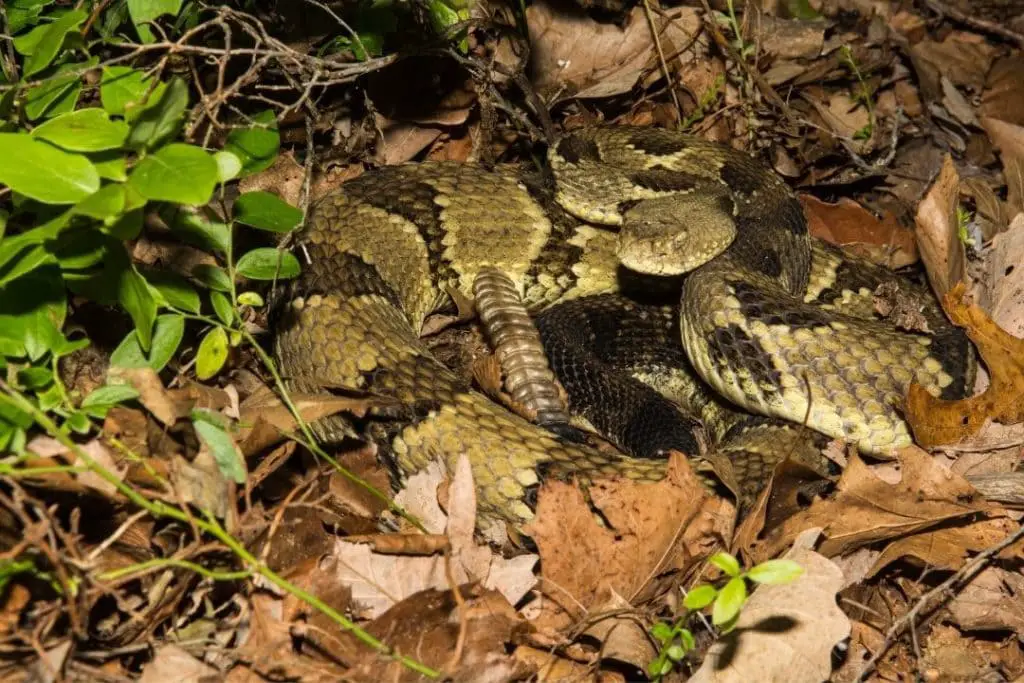
Timber rattlesnakes (Crotalus horridus) are also called canebreak rattlesnakes.
They can be found in the eastern part of Texas in wooded or swampy areas. They are 3 to 5 feet long as adults and weigh no more than 2 pounds.
Males are typically larger and heavier.
They are typically brown or tan with wide crossbands down the body. They have a black tail. They have four different types of venom depending on where they are found. The most common in Texas is neurotoxic.
3. Mottled Rock Rattlesnake
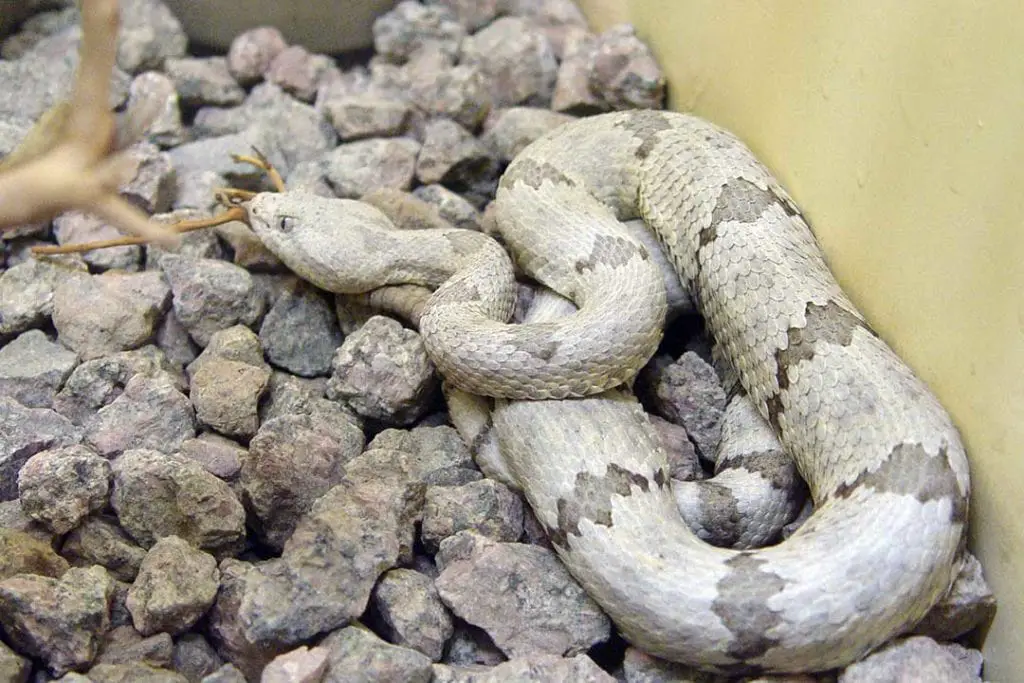
Mottled Rock Rattlesnakes (Crotalus lepidus lepidus) are found in southwestern Texas.
There are two related subspecies found in the state. This particular one is only found in the mountainous areas of the west. They tend to be under 3 feet long and they tend to be cream or light pink in color.
The ones from Davis Mountain tend to be pink with speckling.
They have a hemotoxic venom that also has some neurotoxic effects. They rarely bite humans since they are shy and their typical habitat is difficult to reach.
4. Banded Rock Rattlesnake

The banded rock rattlesnake (Crotalus lepidus klauberi) is found only in the far west of Texas.
They rarely get longer than 24 inches. They are banded and have a greenish-gray color.
Ones found in the Franklin Mountain range of El Paso County can have a pearly-silver color with black crossbands. It can be hard to tell them apart from the mottled rock rattlesnake since they may breed where their ranges overlap.
Banded rock rattlesnakes typically have no mottling between the bands, which is the only somewhat reliable to tell them apart.
5. Black Tailed Rattlesnake
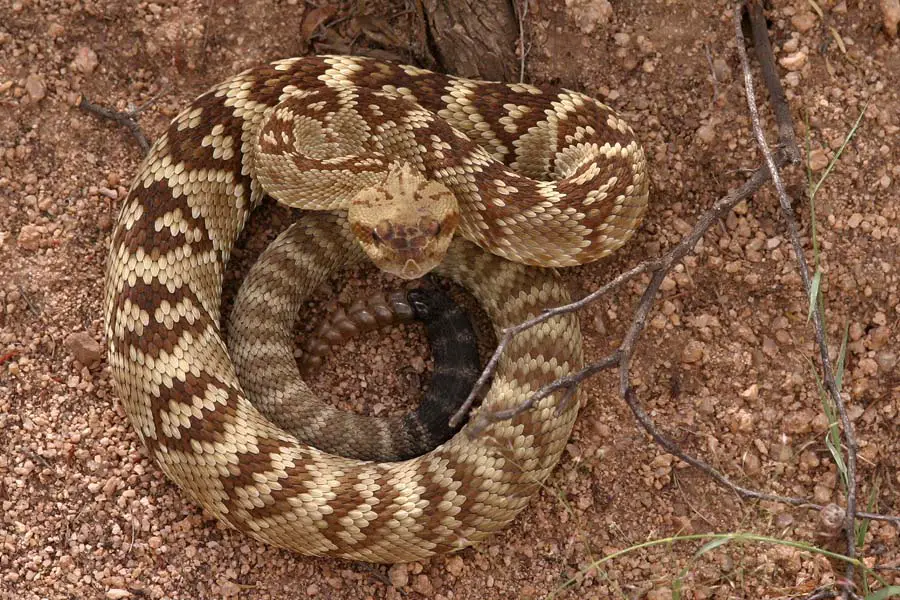
The black-tailed rattlesnake (Crotalus molossus) is found from Central Texas to the western part of the state. They tend to be found in rocky and arid areas.
Black-tailed rattlesnakes are typically 3 and a half feet long but they can get up to 49 inches long. They are heavy animals that weigh between 14 and 24 pounds.
They tend to be gray or olive with dark blotches. They rarely bite thanks to a curious and docile temperament and one of the least toxic venoms out of the rattlesnakes. They have very large venom glands, but this is to make up for the weakness of the venom.
6. Mojave Rattlesnake
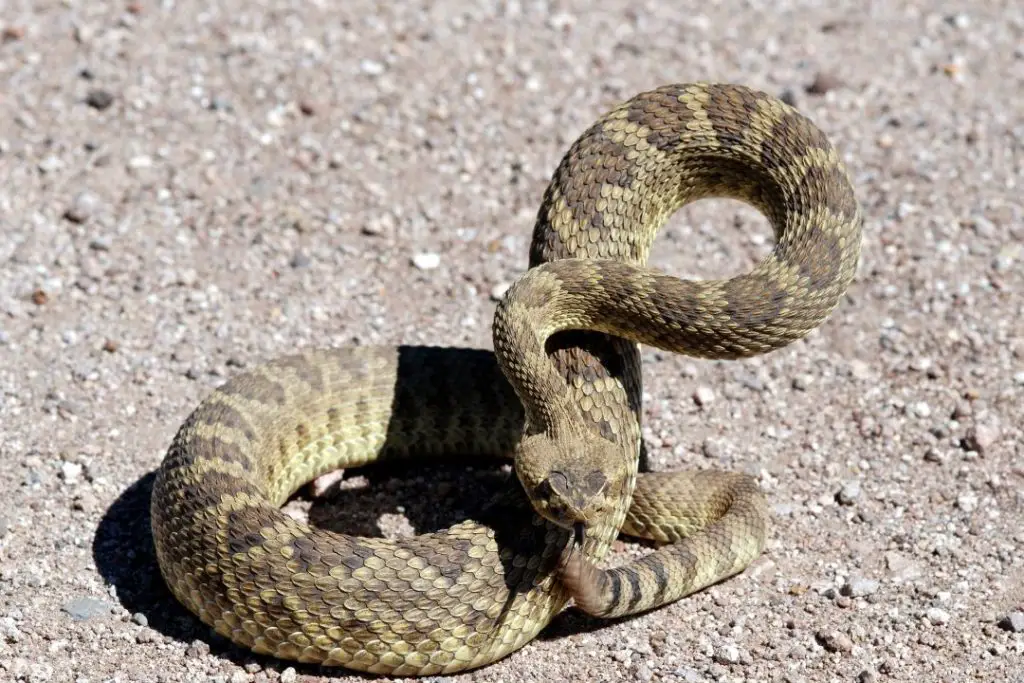
The Mojave rattlesnake (Crotalus scutulatus) is only found in the far west of Texas.
They are easily mistaken for the western diamondback rattlesnake, but they are smaller and typically more slender. They are typically under 3 feet long but can reach up to 4.5 feet long.
They are highly venomous and snake bites can be fatal without treatment. Bites may not produce symptoms at first, but you should always seek out treatment if you are bitten.
7. Prairie Rattlesnake
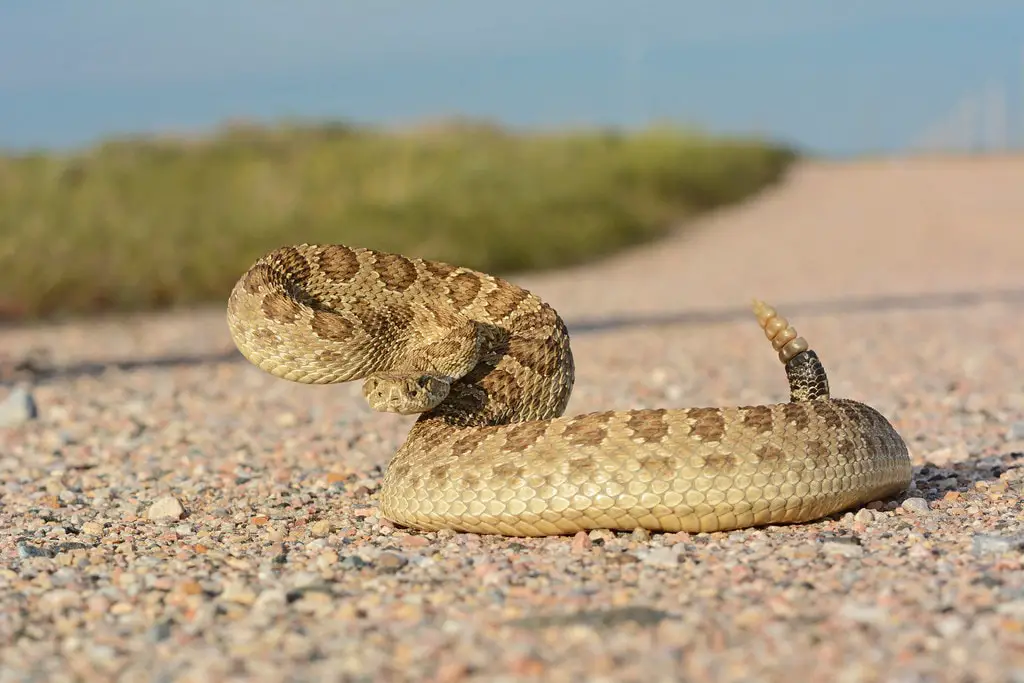
The prairie rattlesnake (Crotalus viridis viridis) is found primarily in grassy plains in the western third of Texas.
They are more slender than other rattlesnakes and tend to be just over 3 feet long and can reach up to 5 feet long.
They tend to be grayish or greenish and have rounded blotches on the back.
They tend to weigh between 8 and 12 ounces. They eat mainly rodents and have a very complex venom due to their wide diet.
8. Western Pygmy Rattlesnake
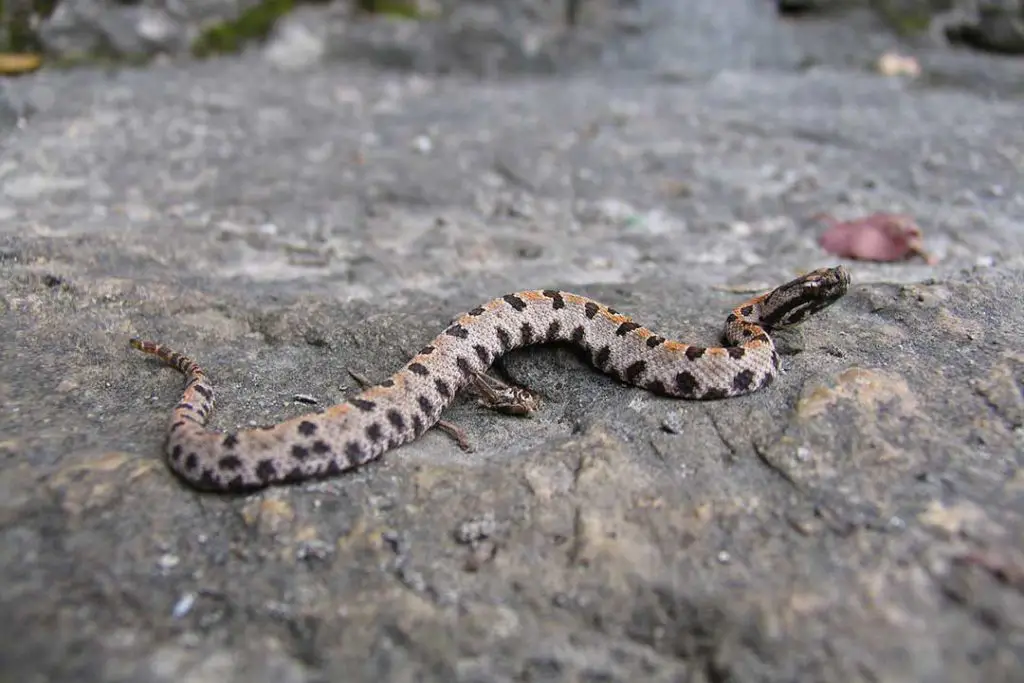
The western pygmy rattlesnake (Sistrurus miliarius streckeri) can be found in eastern Texas. They are typically 16-25 inches long with an average length of 20 inches.
While they do have a rattle, it can be hard to hear since they are so small. They have an irregular dark pattern that stays distinct even in adults.
They tend to be gray but can also be tan or pink with elongated markings.
There are no reported fatalities in humans, but snake bites are very painful and can easily become infected or gangrenous due to the effects of the venom on blood cells and circulation.
Swelling and pain are common symptoms. This venomous snake species tends to prefer woodland habitats, but can be found in many areas. Always be careful in areas with this snake since they are very small and hard to see.
9. Desert Massasauga
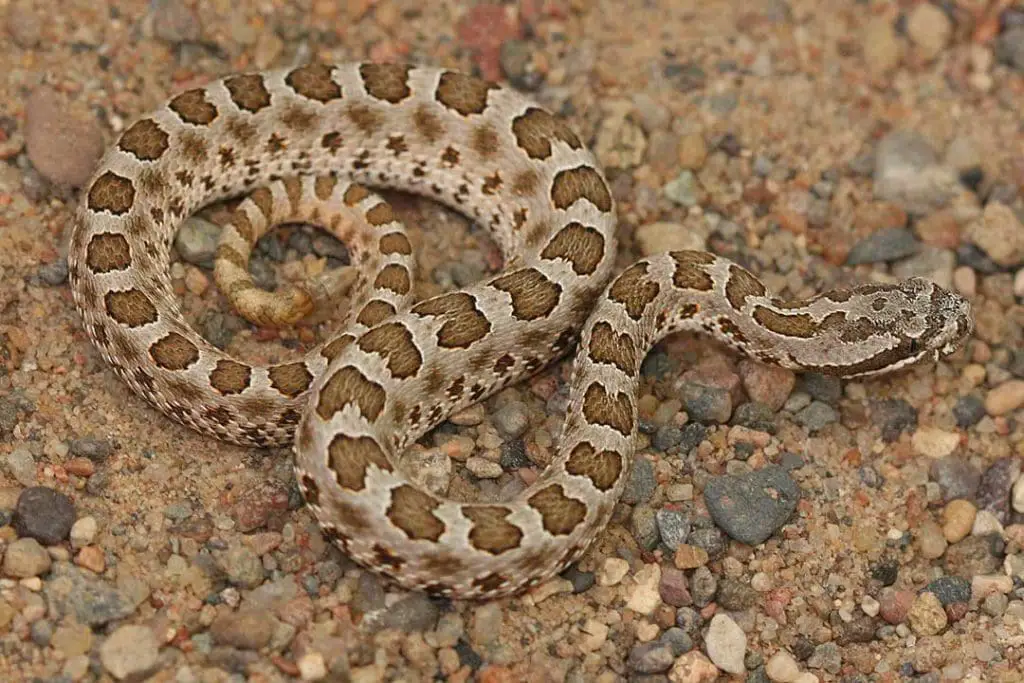
The desert massasauga (Sistrurus catenatus edwardsii) is one of two species of massasauga rattlesnake in Texas.
The desert massasauga is found in West Texas up to the Colorado River, Rio Grande, and some Gulf Coast islands. As the name implies, they prefer arid and semiarid habitats.
They are the smaller of the subspecies and rarely get over 21 inches long. They are tan and brown to help camouflage in their rocky, dry habitat.
Their small size means that their rattle is much higher pitched than other species of rattlesnakes.
While their venom is very toxic, it is not considered deadly since they cannot deliver a large enough dose to be fatal to humans. Bites are incredibly painful and can cause severe damage without treatment.
10. Western Massasauga

The Western massasauga (Sistrurus catenatus tergeminus) is found in Central and Eastern Texas to the Colorado River.
It does interbreed with the desert massasauga where they share a range, so some animals in the region are actually hybrids that blend traits of each subspecies.
They are 14-36 inches long with an average of 27 inches long. They are light gray or tan-gray with dark brown blotches. They prefer grassland habitats or rocky hillsides.
Their prey is primarily rodents but they will also eat lizards and frogs. Like the desert massasauga, their venom is not fatal but it is very painful and potentially disfiguring without treatment.
Copperhead
The copperhead has two species in Texas.
They used to be considered subspecies of the eastern copperhead, but it has been determined that all three former copperhead snakes subspecies found in the state are separate species entirely.
Copperheads tend to be a reddish-brown and prefer more humid areas. Most species can be found near bodies of water in the spring where they hunt aquatic prey.
Copperhead snakes also frequently consume invertebrates such as cicadas.
11. Eastern Copperhead
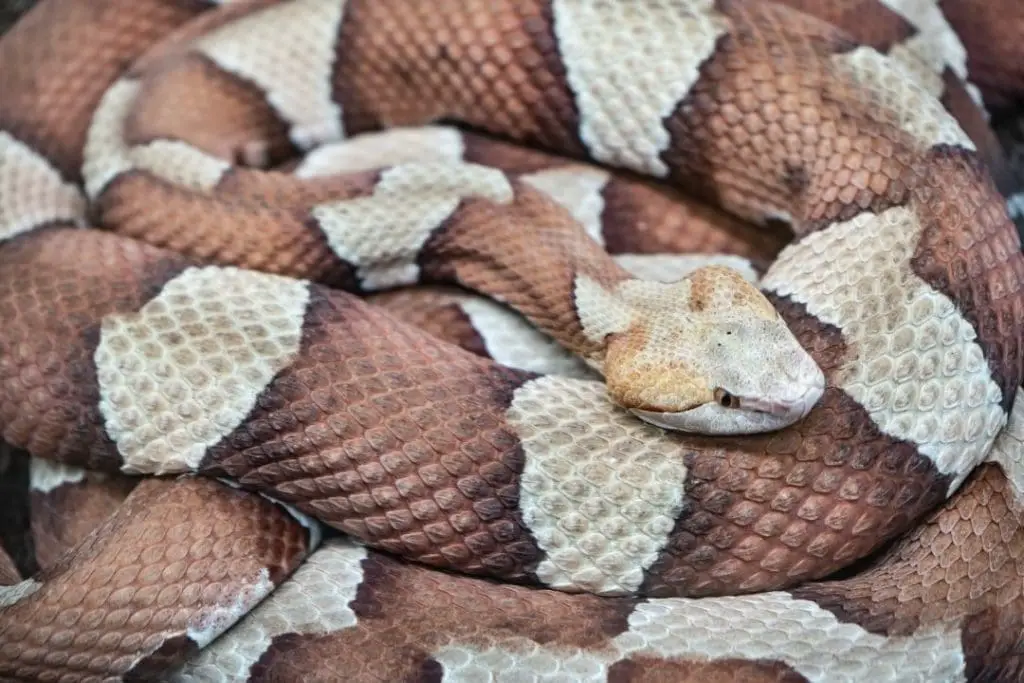
The Eastern copperhead (Agkistrodon contortrix) is found in the eastern third of Texas.
They tend to be 20-30 inches ling and are heavy-bodied animals. They have broad heads where the top of the mouth extends further than the bottom of the chin.
They have a light background color with brown or reddish crossbands that give them their common name. They are nocturnal and typically shy.
They prefer damp areas and will live in rocky areas or wooded regions with damp soil. They have a wide diet and their venom is rarely fatal for a healthy adult.
It is very painful and can cause swelling and tissue death. Severe bites with large amounts of venom or bites to children or older people may require treatment with an antivenin.
Copperheads are known for warning bites that deliver little to no venom, but infections from the tissue damage is common. Always seek out medical treatment.
12. Broad-banded Copperhead
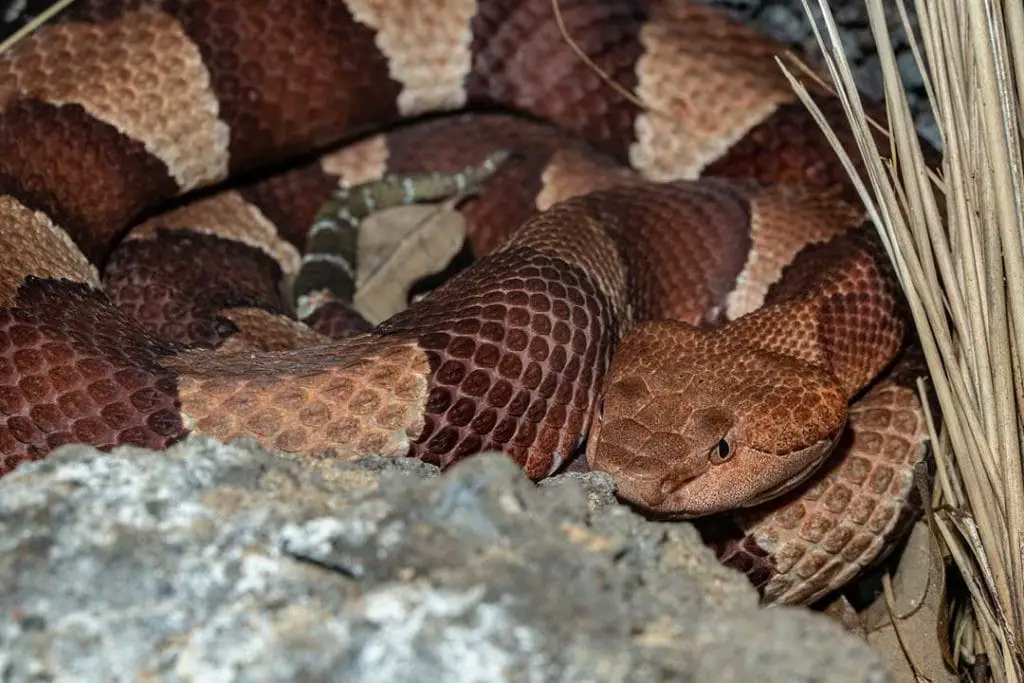
The broad-banded copperhead (Agkistrodon laticinctus) used to be considered two separate subspecies of copperhead. The common names were the broad-banded copperhead and the Trans-Pecos copperhead.
A genetic study proved they belonged to a single population fo a separate species. They are found scattered throughout Central and western Texas.
They are very similar in size and appearance to the Eastern copperhead, but they have wider banding on average. Eastern copperheads have bands that typically narrow near the spine.
Broad-banded copperheads have bands that stay the same width over the body. Much like the Eastern copperhead, they have weak venom that is rarely fatal to humans.
Medical attention is still required since there can be complications from the bite of any venomous snake.
13. Northern Cottonmouth
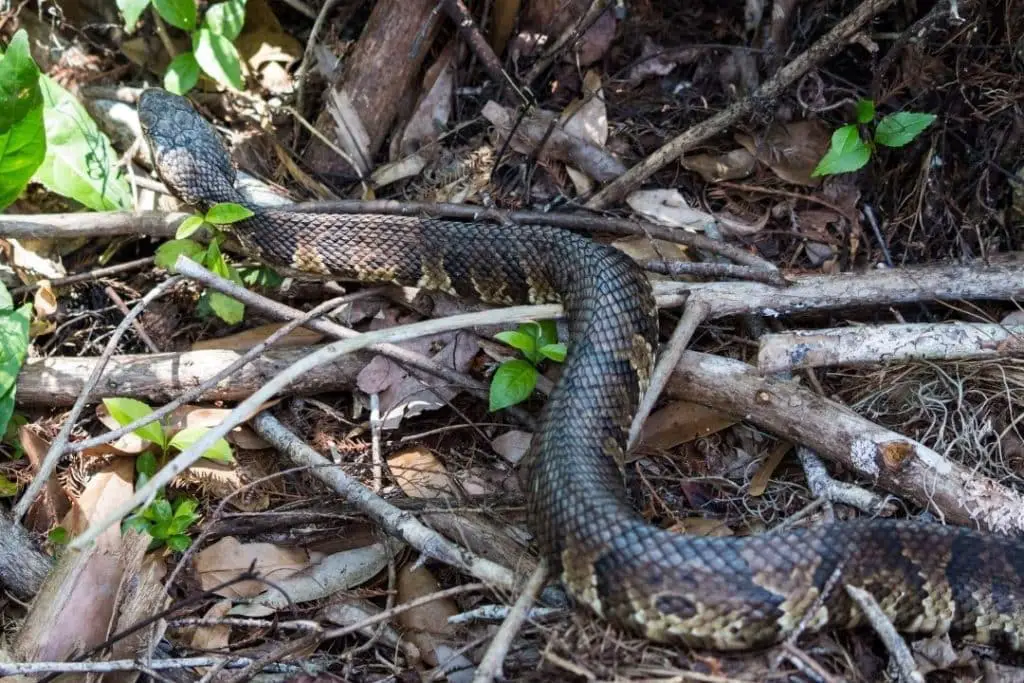
There is only a single species of cottonmouth snakes (Agkistrodon piscivorous) found in Texas.
Snakes from Texas used to be classified as the Western cottonmouth subspecies, but studies proved that the Western cottonmouth and the Eastern cottonmouth are the same species and that there are no subspecies.
Both are now referred to as Northern cottonmouths to differentiate them from the Florida cottonmouth.
Cottonmouths ate found in the eastern half of Texas and heavily prefer habitats near bodies of water.
They are semi aquatic pit vipers and heavily prefer aquatic prey but will also eat small mammals. They average at 26 to 35 inches long, but they can reach up to 71 inches long. They are heavy-bodied and males weigh more than females on average.
Adults water moccasins are typically dark with vert little visible patterning, but juveniles can be some shade of brown with much darker patterning.
The inside of the mouth is a bright white. A threatened cottonmouth will gape its mouth open to try to warn off potential threats.
The venom of a cottonmouth is unlikely to kill, but it is very painful and can cause severe tissue damage. Some victims may require amputation if they are not treated promptly. However, bites are rare.
14. Texas Coral Snake
There is one species of coral snake (Micrurus tener) found in the eastern and southern portions of Texas. These are members of Elapidae, the same family as cobras.
They tend to be small and slender, with animals rarely reaching 3 feet and a diameter of an inch.
The Texas coral snake is noted by its bright colors.
This is one of two species of coral snake where the mnemonic “red touches yellow kills a fellow” applies. Coral snakes have many mimics, but none of the species that share their range have the same pattern of banding.
They are often confused with the non-venomous milk snake, see this article for differences between them.
You should be careful though, since even wild coral snakes tend to have aberrant patterns or lack a pigment such as red, yellow, or black.
Albino animals and animals that are almost entirely black have been reported.
This can lead to misidentification and bites if you decide to handle them.
Coral snakes with unique color morphs can be told apart by their very short face and their unique threat display of lifting their tail.
They are burrowing animals and are rarely seen on the surface, but they can be found under logs or brush.
While they are reluctant to bite and don’t always deliver venom, their venom can lead to slurred speech and respiratory failure in humans. They do have an effective antivenin, but it is still best to avoid being bitten since they can kill within hours.
FAQ
These are some common questions about venomous snakes in Texas. If your question isn’t answered here, please ask in the comment section below.
What is the Most Dangerous Snake in Texas?
The coral snake is the most dangerous snake in Texas. Even a potentially fatal bite causes very little pain so victims have been known to avoid medical treatment.
Most other venomous snakes in Texas struggle to kill a healthy adult.
The coral snake is the most venomous snake in Texas.
Does Texas Have Cobras?
The short answer is no, there are no native cobras in Texas. All true cobras are members of the Naja genus and are native to Africa and a huge part of Asia.
King cobras are a separate genus Ophiophagus. Some snakes that have a habit of trying to stretch their head and neck to intimidate potential predators are sometimes called cobras, but they are not cobras.
Coral snakes are members of the same family as cobras, Elapidae, and there are cobras owned by zoos, venom labs, and private citizens with a permit.
How can You Tell if a Snake is Venomous in Texas?
There are no traits entirely unique to venomous snakes. While rattlesnakes are obvious with their rattle, other snakes will rattle their tail in the brush to mimic the sound.
Pit vipers like copperheads, cottonmouths, and rattlesnakes have wide heads, but many snakes will make their head wider as a defensive behavior.
Coral snakes are very slender and have a barely distinct head. Many harmless snakes like kingsnakes look like coral snakes. Harmless hognose snakes have a very similar pattern to some rattlesnakes.
This makes it hard to identify venomous snakes with a single set of rules.
It is best to learn what the species of venomous snakes look like and treat all snakes with respect. Never try to handle any wild snakes or try to harm them.
Most bites occur when people try to harm a snake. All snakes prefer to avoid conflict and will leave if you give them a chance to escape. If you have a venomous snake in or near your home, it is best to call a professional to remove it safely.
When are Venomous Snakes Most Active in Texas?
Spring is the time you will see the most venomous snakes out and about in Texas. Rattlesnakes are most active at night, but different species are most active at different times of the year.
What is the Difference Between Poisonous and Venomous?
Poisonous animals are toxic to things that eat them. Venomous animals inject a toxin for defense or catching prey. Venom in snakes is a modified saliva, so they use their teeth to inject their venom.
Can You Own a Venomous Snake in Texas?
You can own non-native venomous snakes with a permit that costs $20. You can breed venomous snakes with a more expensive permit.
If you want to own a venomous snake, make sure that you understand how to handle them safely and own all the safety equipment you need.
Native venomous snakes may not be allowed, so check to see what species are allowed. Some species may be considered threatened or are just not legal in your city.
Resources
- National Natural Toxins Research Center – Texas A&M
- Snakes FAQ – Texas Parks & Wildlife
- Venomous Snake Bites – Texas Health and Human Services
Conclusion
Venomous snakes can be found in nearly every part of Texas. Make sure you are careful if you are in their habitat and watch where you step.
Most bites from venomous snakes happen because someone stepped on the snake. If you have any questions or comments, please leave them below.
